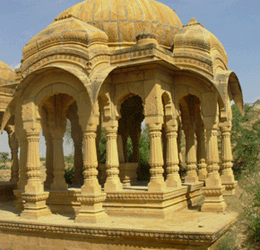Spooky or eerie places weather real or just legends passed down from generations after generations never fail to attract tourists . Unlike old monuments or palaces, etc of historical value, visiting such spine-chilling places gives them a strange experience involving ''anxiety factor.'' Rajasthan has no such ghost places but villages like Bhangarh and Kuldhara are said to be unearthly places perhaps due to the legends associated with them.
Once a prosperous village, Kuldhara, 17km west of Jaisalmer, has now turned into a ghost town with full of ruins all over, purportedly carrying a curse. Though it is not a very popular tourist place, driven by curiosity, a lot of people visit this haunted place. Upon nearing this village, overcome by fear or superstition, visitors do not want to risk their lives by staying overnight and try to leave the place as fast as they can long before sundown.
 |
| Kuldhara, ghost village, Rajasthan, India. the hindu.com |
Haunted, spooky and cursed places or buildings are frequently associated with tyranny, torture, suicide, blood shed etc., that might have occurred in the past and, obviously, they attract the attention of gutsy and highly spirited people. In such cases rumor mills never fail to work over time and add zest to the strange story by giving an incredible twist to it. But, in this deserted village there is no such tragedy as of now except the curse hanging thick over it. Such places, whether myth or real, always carry a ting of pathos and pain and we hardly ever leave them unaffected.
Kuldhara village can be reached by taxi. and no one lives in Kuldhara, as well as in its 85 fringe villages, as they are believed to have been cursed by the Paliwal Brahmin community who lived here in the past. There are some dilapidated houses, temples and dusty roads that are reminiscent of their past comfortable life.
Kuldhara was once a vibrant and lively village of Paliwal Brahmins. It is believed that the residents of Kuldhara village refused to give their chieftain's beautiful daughter in marriage to the local Dewan of Jaisalmar Salim Singh. The Dewan fell in love with the Brahmin girl and made threats to the brahmin community to whom honor, dignity and self-contented life were more important than the materialistic and transient life. Since 1300 AD the Brahman community had lived there cultivating water-intensive crops.
in a desert area and leading a simple and pious life dedicated to Lord and meditation.
To avoid being insulted and humiliated by the local ruler, they cursed the place before abandoning Kuldhara in 1825 on the day of Rakshabandhn. They cursed any body who wanted to settle down there or in the near-by villages won't live in peace and would die soon. The residents of adjoining 85 villages followed suit left their homes overnight for good. That is why many of the Paliwal Brahmins do not celebrate this festival. Their whereabouts are not known yet, rumor has it that they are now living in Jodhpur. To this date, the village remains barren; left almost the same as its inhabitants had left it centuries ago. It is also said that people who have tried to stay there at night have been chased away by strange paranormal phenomenon.
'Kuldhara and its ruins' are protected monuments and are maintained by the Archaeological Survey of India (ASI). There are rows of mud houses, with damaged roofs and walls and the building - village center is fairly in good shape with a stairway. However, the desolate village has a dry and dusty road wearing a forlorn look and tourists mention that when they leave this place their heart is filled with sadness and it takes a while for them to shake off the poignant feeling, they had experienced at Kuldhara.














